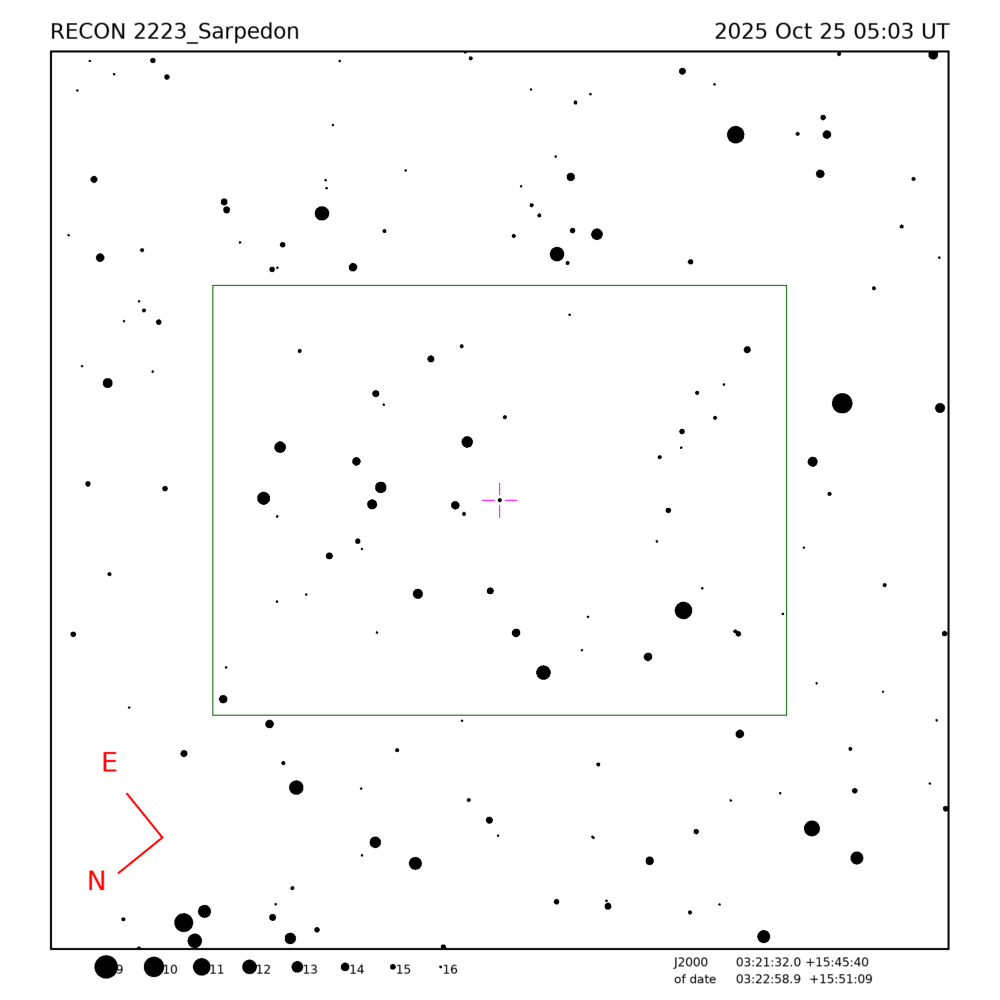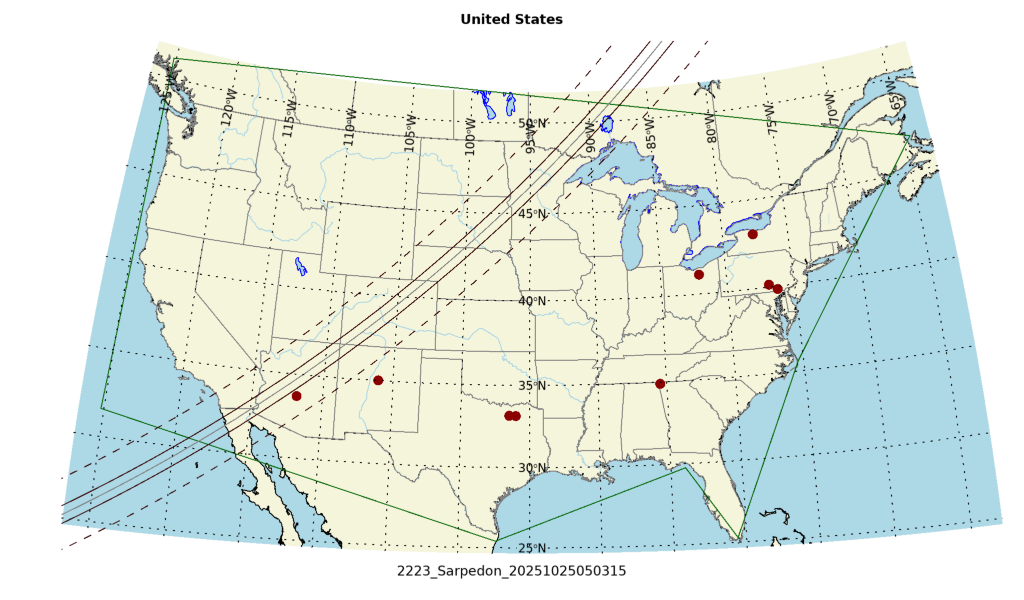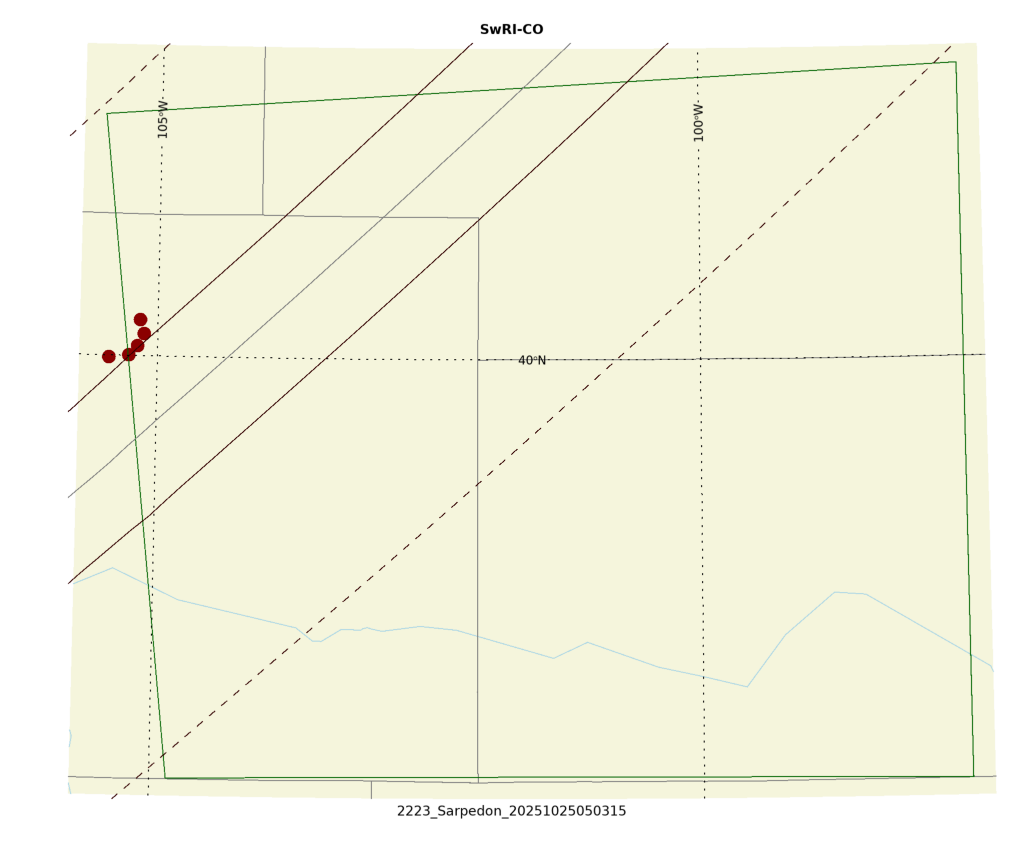
Occultation event with (2223) Sarpedon, event index number 1412
Regions able to see the event: US,RECON,SwRI-CO
Geocentric closest approach at 2025/10/25 05:03:15 UTC
J2000 position of star is 03:21:32.0 +15:45:40
Equinox of date position of star is 03:22:58.9 +15:51:09
Star is 158 degrees from the moon. Moon is 12% illuminated.
Stellar brightness G=16.2, apparent brightess of occulting body is G=14.1
Use an exposure time of 1.15 seconds with the standard RECON-QHY system.
SNR of 3.3 per integration for unocculted signal
Expected flux drop is 13% with SNR of 0.4 for the occulted depth (per occulted point)
Apparent velocity is 16.4 km/sec on the sky relative to the star, or, 18.6 arcsec/hr.
Position angle of asteroid motion is 61.5 degrees
The recommended exposure time corresponds to 18.8 km per image.
The 1-sigma error in the time of the event is 1.2 seconds.
The 1-sigma cross-track error in the shadow position is 38.7 km.
The sky-plane scale is 3173.7 km/arcsec.
Diameter estimates:
90.4 km assuming a 5% albedo, maximum of 5.5 sec for a central chord
36.9 km assuming a 30% albedo, maximum of 2.3 sec for a central chord
Cross-track diameter of 77.5 km used for deployment plan.
Star training set for 2223_Sarpedon, (2025/10/25 05:03UT) Object RA Dec mag sep mel Aldebaran 04:37:24.3 +16:33:33 0.8 17.87 169 Menkar 03:03:37.9 +04:11:22 2.5 12.59 147 PPM 119093 03:28:44.3 +12:49:26 6.5 3.33 158 PPM 118986 03:19:53.7 +15:16:05 8.4 0.95 158 PPM 119007 03:21:29.3 +15:44:59 8.8 0.37 158 2223_Sarpedon 03:22:58.9 +15:51:09 14.1 159 Positions are for equinox of date

This table contains the target star visibility for registered US sites that are relevant for this occultation. This list has been filtered to only those sites that can see the field and are within range of the shadow given the uncertainties. The observing time range has been calculated to cover the time of the event at each site with allowances for the event timing uncertainty plus time for obtaining a pre and post event baseline lightcurve. This set of stations has a 16.7 % chance of getting at least one chord. There is a 0.0% chance of 2 or more chords assuming clear weather for all.
| Site Name | Site mid-time (UT) |
Sun alt (deg) |
Sky | Moon | Star alt (deg) |
Star az (deg) |
Target | Observing Time | Xtrack (km) |
Prob |
|---|---|---|---|---|---|---|---|---|---|---|
| George/Scottsdale | 05:05:54 | -54.2 | Dark | Down | 40.1 | 97.8 | Up | 05:02:54-05:08:54 | -69.9 | 0.167 | Patrick | 05:05:31 | -57.4 | Dark | Down | 44.5 | 102.9 | Up | 05:02:31-05:08:31 | -241.9 | 0.000 |

This table contains the target star visibility for registered RECON sites that are relevant for this occultation. This list has been filtered to only those sites that can see the field and are within range of the shadow given the uncertainties. The observing time range has been calculated to cover the time of the event at each site with allowances for the event timing uncertainty plus time for obtaining a pre and post event baseline lightcurve. This set of stations has a 89.2 % chance of getting at least one chord. There is a 8.2% chance of 2 or more chords assuming clear weather for all.
| Site Name | Site mid-time (UT) |
Sun alt (deg) |
Sky | Moon | Star alt (deg) |
Star az (deg) |
Target | Observing Time | Xtrack (km) |
Prob |
|---|---|---|---|---|---|---|---|---|---|---|
| Wildwood | 05:06:06 | -49.1 | Dark | Down | 34.6 | 93.9 | Up | 05:01:39-05:07:39 | 242.7 | 0.000 | North Las Vegas | 05:05:47 | -50.5 | Dark | Down | 37.0 | 97.6 | Low | 05:01:48-05:07:48 | 240.3 | 0.000 | Idyllwild | 05:06:05 | -50.6 | Dark | Down | 36.2 | 94.8 | Up | 05:01:35-05:07:35 | 142.2 | 0.002 | Laughlin/Bullhead City | 05:05:52 | -51.5 | Dark | Down | 37.7 | 97.2 | Up | 05:01:30-05:07:30 | 139.6 | 0.003 | Kingman/Dolan Springs | 05:05:51 | -51.9 | Dark | Down | 38.1 | 97.5 | Up | 05:00:56-05:06:56 | 119.4 | 0.013 | Lake Havasu City | 05:05:55 | -52.0 | Dark | Down | 38.0 | 96.8 | Up | 05:02:46-05:08:46 | 86.9 | 0.082 | Calipatria | 05:06:05 | -51.8 | Dark | Down | 37.2 | 95.0 | Up | 05:01:52-05:07:52 | 51.9 | 0.302 | Yuma | 05:06:06 | -52.7 | Dark | Down | 38.0 | 95.3 | Up | 05:02:47-05:08:47 | -14.7 | 0.576 |

This table contains the target star visibility for registered SwRI-CO sites that are relevant for this occultation. This list has been filtered to only those sites that can see the field and are within range of the shadow given the uncertainties. The observing time range has been calculated to cover the time of the event at each site with allowances for the event timing uncertainty plus time for obtaining a pre and post event baseline lightcurve. This set of stations has a 42.9 % chance of getting at least one chord. There is a 42.0% chance of 2 or more chords assuming clear weather for all.
| Site Name | Site mid-time (UT) |
Sun alt (deg) |
Sky | Moon | Star alt (deg) |
Star az (deg) |
Target | Observing Time | Xtrack (km) |
Prob |
|---|---|---|---|---|---|---|---|---|---|---|
| Dunrhomin | 05:05:01 | -54.4 | Dark | Down | 43.7 | 108.5 | Up | 05:02:01-05:08:01 | 49.5 | 0.322 | Nederland | 05:05:03 | -54.4 | Dark | Down | 43.6 | 108.0 | Up | 05:02:02-05:08:02 | 46.1 | 0.351 | TinkerMill | 05:05:01 | -54.5 | Dark | Down | 43.8 | 108.4 | Up | 05:02:02-05:08:02 | 42.0 | 0.386 | Nikitin | 05:05:02 | -54.5 | Dark | Down | 43.7 | 108.3 | Up | 05:02:03-05:08:03 | 39.3 | 0.409 | CU-SBO | 05:05:02 | -54.5 | Dark | Down | 43.7 | 108.2 | Up | 05:02:01-05:08:01 | 38.8 | 0.414 |

Star training set for 2223_Sarpedon, (2025/10/25 05:03UT) Object RA Dec mag sep mel Aldebaran 04:35:55.4 +16:30:29 0.8 17.87 169 Menkar 03:02:16.8 +04:05:21 2.5 12.59 147 PPM 119093 03:27:18.7 +12:44:07 6.5 3.33 158 PPM 118986 03:18:27.2 +15:10:31 8.4 0.95 158 PPM 119007 03:20:02.5 +15:39:28 8.8 0.37 158 2223_Sarpedon 03:21:32.0 +15:45:40 14.1 158 Positions are for J2000